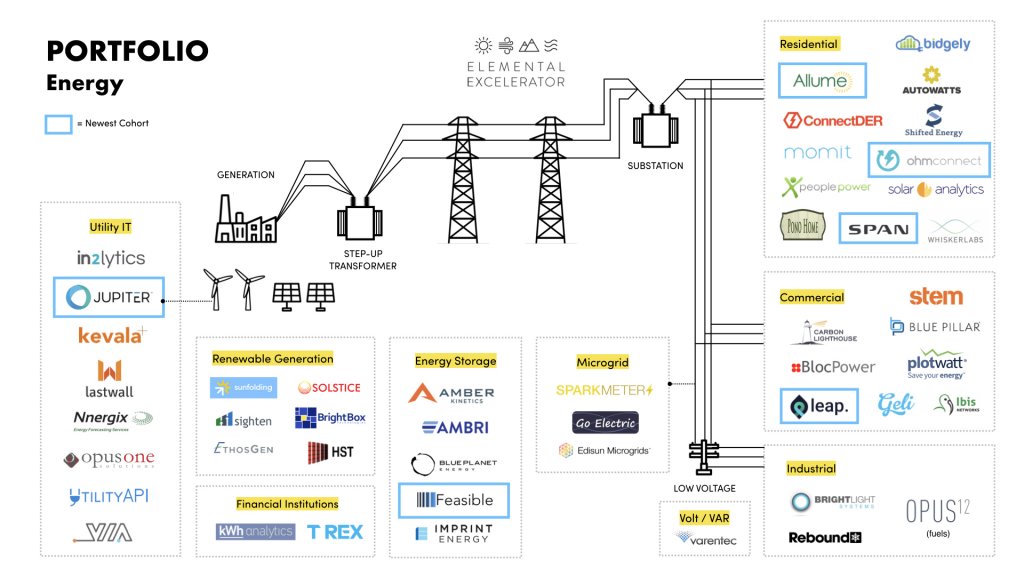
We are thrilled to announce that applications for our 9th cohort of climate-tech startups are officially open!
The space between 99 and 100
We’ve spent the past ten years working to accelerate solutions to climate change and deploy those solutions in the communities that need them the most. To date, we have provided $36M in funding to 99 startups that have raised nearly $800M in follow-on funding.
Our portfolio companies are working on everything from expanding access to solar power in frontline communities and slashing methane emissions by feeding cows seaweed to deploying portable water quality sensors and mapping equity into street infrastructure. Hitting 99 companies was an appropriate milestone to end our first decade, and a strong foundation for our mission. Now, crossing over the threshold of 100 is a resonant moment as we enter what must be a decade of climate action.
What will that 100th company be? Who will link arms with our portfolio of entrepreneurs impacting the lives of so many people, communities, and industries? Will you join our 99 champions of planet Earth who are building a cleaner and more equitable tomorrow?
 “As we enter the decisive decade in which humanity must collectively act to avoid almost unimaginable suffering, it is imperative that we commercialize and scale climate solutions for communities around the world. As one of the first to adapt the tech accelerator model to clean energy and climate-tech startups, Elemental has spent the last decade building a platform to best serve entrepreneurs. We are excited to enter the next decade with a focus on equitably scaling climate fixes at a global level.” — Dawn Lippert, CEO
“As we enter the decisive decade in which humanity must collectively act to avoid almost unimaginable suffering, it is imperative that we commercialize and scale climate solutions for communities around the world. As one of the first to adapt the tech accelerator model to clean energy and climate-tech startups, Elemental has spent the last decade building a platform to best serve entrepreneurs. We are excited to enter the next decade with a focus on equitably scaling climate fixes at a global level.” — Dawn Lippert, CEO
What do we look for in a startup?
For our 9th cohort, we seek 15-20 startups from any country in the world focused on addressing challenges in energy, mobility, agriculture, water or the circular economy. Applicant startups have typically secured seed-to-Series C funding, employ a minimum of two full-time employees and have a working prototype.
Startups may apply for one of three tracks:
- Go-to-Market Track, which provides up to $200,000 to Seed – Series A companies for customer discovery and validating a scalable business model;
- Demonstration Track, which provides up to $1M to Series A companies and beyond for project deployment in Hawaiʻi or Asia Pacific;
- Equity & Access Track, which provides up to $1M to Series A companies and beyond for companies that increase access to innovation in California’s frontline communities — the predominantly low-income and minority communities that are experiencing multiple and cumulative sources of pollution and the impacts of climate change first.
 “We believe that the answers to a more equitable, sustainable world lie in the nexus of community and climate solutions. That’s why we use a place-based model of innovation, working closely with communities, local businesses, industry partners and policy-makers to help cohort companies successfully scale their businesses and deploy projects where they’re needed most.” — Sara Chandler, Director of Innovation, Equity & Access
“We believe that the answers to a more equitable, sustainable world lie in the nexus of community and climate solutions. That’s why we use a place-based model of innovation, working closely with communities, local businesses, industry partners and policy-makers to help cohort companies successfully scale their businesses and deploy projects where they’re needed most.” — Sara Chandler, Director of Innovation, Equity & Access
Challenges and Solutions
The challenges we seek to solve are some of the biggest facing our planet, in systems that impact peoples’ lives on a daily basis. And we’re looking for solutions to tackle them in ways that are scalable and equitable.
 “In 2019, we funded companies tackling everything from demand response to hyperlocal climate risk analysis to democratizing access to renewable energy. In 2020, we’re looking for companies whose innovations help us accelerate the transition to a more equitable, resilient, and sustainable energy sector.” — Nneka Uzoh, Director of Energy Innovation
“In 2019, we funded companies tackling everything from demand response to hyperlocal climate risk analysis to democratizing access to renewable energy. In 2020, we’re looking for companies whose innovations help us accelerate the transition to a more equitable, resilient, and sustainable energy sector.” — Nneka Uzoh, Director of Energy Innovation
There are several key problems we seek to address in the global energy sector. First, we must drive faster adoption of clean energy technologies. At the same time, we need to reduce greenhouse gas (GHG) emissions from existing energy sector systems. We also need to improve energy resilience as we face increasingly frequent climate-related events; this is particularly true in disadvantaged communities, many of which are disproportionately affected by natural or man-made disasters.
The solutions we are looking for cover a wide range of technologies and verticals, including:
- Energy technologies at the nexus of other sectors, such as water and food
- Robotics, A.I. and machine learning
- Asset management tools easily integrate with and optimize current systems
- Manufacturing, commercial and industrial energy solutions
- Grid design and safety
- Energy efficiency
- Carbon sequestration and capture
- Affordable clean energy options for low-to-medium income customers
- Democratization of energy
- Electrification of everything

 “The transportation sector generates an enormous amount of GHG emissions, representing the largest share of total U.S. emissions, largely from internal combustion engine vehicles. This, and the fact that mobility is highly correlated with economic opportunity and quality of life, guides our investment in new mobility solutions.” — Danielle J. Harris, Director of Mobility Innovation
“The transportation sector generates an enormous amount of GHG emissions, representing the largest share of total U.S. emissions, largely from internal combustion engine vehicles. This, and the fact that mobility is highly correlated with economic opportunity and quality of life, guides our investment in new mobility solutions.” — Danielle J. Harris, Director of Mobility Innovation
Despite a raft of new mobility solutions that have appeared over the past decade, there remain significant barriers to transitioning to a cleaner and more equitable transportation system. There are still major inefficiencies in personal vehicle ownership and usage. This is compounded by network pressures from growing congestion and roadway demand and a lack of usable data on roadway usage, safety and maintenance. We still see significant gaps in reliable and affordable mobility options for residents of frontline communities. And we must also reduce GHG emissions from existing air and water transportation industries.
The mobility solutions we’re looking for to address these challenges include:
- Affordable, appealing and reliable mobility options for those most in need, including super commuters, seniors and frontline communities
- Behavior change solutions to reduce single-occupancy vehicles and vehicle trips
- Increased convenience, appeal and access to electric transportation
- Reduced emissions in heavy freight, shipping, logistics and air travel
- Enhanced roadway infrastructure safety, resiliency and disaster planning
 “Recent reports from the Intergovernmental Panel on Climate Change illustrate the global food systemʼs significant contribution to climate change. We seek companies whose innovations increase local food production and decrease emissions throughout the value chain, from farm to fork.” — Danya Hakeem, Director of Agriculture & Circular Economy Innovation
“Recent reports from the Intergovernmental Panel on Climate Change illustrate the global food systemʼs significant contribution to climate change. We seek companies whose innovations increase local food production and decrease emissions throughout the value chain, from farm to fork.” — Danya Hakeem, Director of Agriculture & Circular Economy Innovation
Our global food system, from production to distribution and consumption, is largely based on unsustainable and outdated practices. It is critical that we enhance resilience and self-sufficiency, harness the potential of agriculture, forestry, and other land uses to address climate change, and improve access to economically viable technology solutions for small farmers around the world. We must also reduce GHG emissions associated with production, distribution and waste in the food and agriculture sectors.
To overcome these challenges, we’re looking for companies that focus on the following areas:
- Carbon sequestration and soil health
- Food safety and traceability
- Waste reduction and diversion
- Alternative proteins
- Reduce or combat deforestation
- Supply chain platforms that support increased access to food, resources, land
- Reduce energy use, toxic synthetic inputs and the overuse of water

 “Most public capital goes to centralized infrastructure, overlooking opportunities for improvement elsewhere in the water ecosystem. We prioritize technologies that take a decentralized approach, help municipalities and utilities reduce pollution, and advance solutions to provide clean water for all.” — Kim Baker, Director of Water Innovation
“Most public capital goes to centralized infrastructure, overlooking opportunities for improvement elsewhere in the water ecosystem. We prioritize technologies that take a decentralized approach, help municipalities and utilities reduce pollution, and advance solutions to provide clean water for all.” — Kim Baker, Director of Water Innovation
Our water systems face such severe threats that, as the New York Times noted, “a quarter of humanity faces looming water crises.” These threats are varied, ranging from centralized water system challenges combined with aging infrastructure to water stress and scarcity, particularly in frontline communities. We also need better, more sustainable wastewater management and sanitation solutions, in addition to the GHG emissions we need to reduce from the water sector.
The solutions we’re looking to focus on include three main elements of water systems — monitoring and treatment, operations and efficiency, and access.
- Monitoring & treatment includes technologies that address:
- Measurement & repair
- Emerging contaminants and newly regulated substances treatment
- System optimization
- Membrane-related systems
- Decentralized treatment solutions
- Operations & efficiency includes:
- Capital-efficient utility upgrades
- Technology related to human capital
- Data & AI-based maintenance tools
- Access includes:
- Safe, affordable, non-discriminatory drinking water solutions
- Emergency preparedness
- Conservation and water reuse solutions
“Our existing industrial and waste systems are unsustainable and inequitable. As we aspire to redesign waste streams using new technologies and business models, we’re looking for market solutions that create value from greenhouse gas emissions and other waste products, keep products and materials in use, and regenerate natural systems.” — Danya Hakeem, Director of Agriculture & Circular Economy Innovation
The concept of a “circular economy” spans a wide variety of technologies and sectors, with the potential to significantly improve the sustainability and equity of our economy. We are focused on transforming how we make and use everything from cars, clothes, food, and other products, which can account for as much as 45% of emissions. Replacing the “take-make-waste” extractive industrial model with a circular economy framework can also tackle the disproportionate pollution found in frontline communities and energize local job creation.
To solve these problems, we seek companies that focus on:
- Waste-to-value solutions
- Carbon capture and sequestration
- Source reduction and data collection platforms
- Alternative packaging and next generation waste sorting and processing technology
- Resource recovery and reuse (specifically for packaging, e-waste and water)
- Sustainable building materials and technologies
- Textile and apparel recycling (specifically B2B mixed waste, low energy and water use)
- Solutions that create high-quality, local jobs for people who live in frontline communities
- Manufacturing companies interested in ‘Equity IN’ projects to establish diverse hiring, inclusion and retention, and responsible supply chain practices
If you see yourself in these solutions, review our applicant resources and take 15 minutes to apply to be in our next cohort by April 7!




